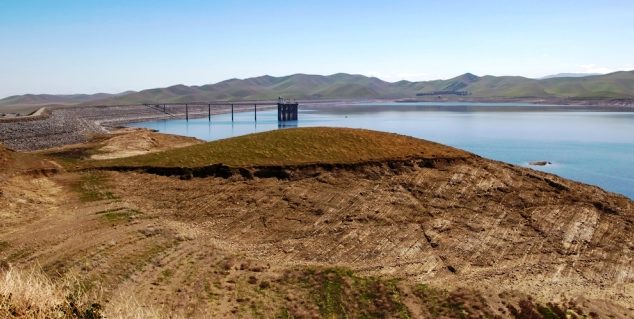Recent News
As California’s drought intensifies, the pain spreads
 Parched San Louis Reservoir along the Pacheco Pass,, at about 55 percent of capacity, as of this month. (Photo: Robert Enriquez, via Shutterstock)
Parched San Louis Reservoir along the Pacheco Pass,, at about 55 percent of capacity, as of this month. (Photo: Robert Enriquez, via Shutterstock)In California, the climate crisis is worsening drought conditions. As a result, the federal Bureau of Reclamation has cut 2022 water supply allocations for Central Valley Project contractors.
“We began the 2022 water year with low CVP reservoir storage and some weather whiplash, starting with a record day of Sacramento rainfall in October and snow-packed December storms to a very dry January and February, which are on pace to be the driest on record,” said Regional Director Ernest Conan, in a prepared statement. “Further, the December storms disproportionately played out this year in the headwaters—heavy in the American River Basin and unfortunately light in the upper Sacramento River Basin, which feeds into Shasta Reservoir, the cornerstone of the CVP.”
“Agricultural water users will look to pump more groundwater to make up for reductions of surface water deliveries.” — Jay R. Lund
Consider the economic geography of CVP water supply in year three of the state’s drought.
Contractors north and south of the Delta will receive 0% of their contract total, according to the BOR. Meanwhile, contractors north of the Delta will receive necessary water allocation for public health and safety needs, the BOR reports.
“Agricultural water users will look to pump more groundwater to make up for reductions of surface water deliveries,” Jay R. Lund, co-director, Center for Watershed Sciences, and a distinguished professor of civil and environmental engineering, at UC Davis, told Capitol Weekly.
Just ask Tony Azevedo, farm manager of the Stone Land Company’s, a 7,000-acre family enterprise in King’s County. The crops that grow at this fourth-generation farm are tomatoes, onions, pistachios, almonds and cotton.
“Sadly, my workers will lose about 10 hours of wage-income a week.” — Tony Azevedo
As a farmer in the Westlands Water District, Azevedo is dealing with the reductions of CVP water allocations on different levels. First, he plans to idle about 1,500 acres of his acreage. Azevedo will also pump more groundwater to compensate for the cut to CVP water allocation from decreased precipitation. Last, he will have to tell his labor force of 71 full-time employees some rather dire news. “Sadly, my workers will lose about 10 hours of wage-income a week,” Azevedo said. “It’s sad because they are family.”
North of the Delta, the CVP water supply reductions also affect growers. Michael Miiller is the director of government relations for the California Association of Winegrape Growers.
“Let’s recognize that we are all impacted by the drought,” he told Capitol Weekly. “Reports show that nearly 385,000 acres of agricultural land in the Central Valley alone sit idle due to drought-related water cutbacks.”
Most of the fallowed agricultural land grows lower value crops such as corn and wheat, according to Professor Lund of UC Davis. He does not see agricultural prices rising from land fallowing. Wheat prices could rise, however, due to events abroad such as Russia’s invasion of Ukraine. Both nations are wheat producers and export the crop on the global market. Corn and wheat are a negligible part of California’s exports to other nations, Lund said.
Golden State growers know that a lack of rainfall is what appears to be the new weather normal.
“The typical California grower knows that this drought is real, is conserving water and is hoping for rain,” according to the CAWG’s Miiller. “However, growers also know that some conservation approaches target agricultural land as a low priority and push for the repurposing of fallowed agricultural land after the drought. Growers believe a collaborative approach in response to the drought would be much better.”
Alexandra Nagy is the California director of Food & Water Watch. She takes a different view of the way forward for water use during the Golden State’s drought. “The only way for California to truly tackle this mega-drought is to curtail the outsize water allocations of profiteering corporate interests,” she told Capitol Weekly.
“Governor Newsom can safeguard our water resources by immediately halting the expansion of water intensive industries like factory farms, almond and pistachio operations, and fossil fuel development, while implementing groundwater withdrawal regulations. Addressing corporate water abuse and protecting our groundwater supplies will codify the human right to water of every Californian.”
Speaking of climate change and water use, the Intergovernmental Panel on Climate Change that the United Nations convened called in part for an end to building new fossil fuel infrastructure as a way to cut the carbon emissions that are in part driving droughts. The 2022 IPCC report, released on Feb. 28, urges elected officials and policymakers to act swiftly as a window to avoid climate change’s worsening impacts is closing fast.
—
Editor’s Note: Seth Sandronsky reports regularly for Capitol Weekly. Contact him at [email protected].
Want to see more stories like this? Sign up for The Roundup, the free daily newsletter about California politics from the editors of Capitol Weekly. Stay up to date on the news you need to know.
Sign up below, then look for a confirmation email in your inbox.

Leave a Reply